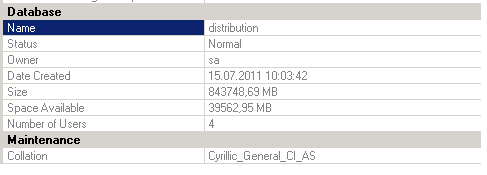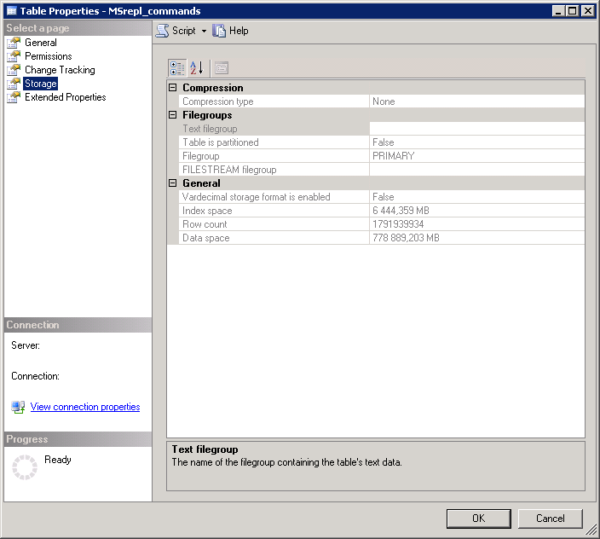Article
Sometimes you have to face the situation when in Microsoft SQL Server with the configured replication, the database distribution starts to grow. There is nothing wrong with the fact that the database starts growing after the replication task is created.
The distribution database stores metadata and log data for all types of replication as well as transactions for transaction replication. However, there is a few weeks after the replication jobs have been created, the database continues to grow this alarm.
It is likely that a database cleanup job is not being performed or is being performed incorrectly. When replication is created, the job is created: Distribution clean up: distribution. In this job, the stored procedure: dbo.sp_MSdistribution_cleanup is started by schedule.
This stored procedure cleans up the distribution database.
To find out the reasons, you should first check:
1. Whether a cleanup job has been created for the distribution database. bbo.sp_MSdistribution_cleanup.
2. Is this task enabled
3. Check the task execution log for errors, one of the frequent errors is the situation when the employee’s account from under which the task is being executed is blocked or has insufficient rights to the distribution database.
4. The schedule of starting the cleanup task is not set or is missing
If there are no problems in the task, it is worth checking what result the command to run in the task returns.
To do this, create a new query (New Query) and run the script:
USE [distribution]
GO
EXEC dbo.sp_MSdistribution_cleanup @min_distretention = 0, @max_distretention = 72
Where, 72 is the retention time of metadata and replication log data. Normally 72 hours is enough, but you may have your own thoughts on this.
If the distribution database hasn’t been cleaned up for a long time, then waiting for the result of this command can take several hours. This depends on the total size of the database, the time that has elapsed since the last cleanup and the server performance.
In particularly severe cases, such as this one:

Removing outdated records can take days or even weeks, not just hours.
It is a matter of a strongly sprawling table MSrepl_commands and MSrepl_transactions. So, on the example below, the number of records is almost 1.8 billion.

In this situation, to speed up the cleaning of the two most extensive tables, you can manually start the table cleaning by deleting most of the data using the command:
USE distribution
GO
DECLARE @rowcountCom int = 1000000
DECLARE @rowcountTr int = 10000
DELETE TOP(@rowcountCom) MSrepl_commands WITH (PAGLOCK)
FROM MSrepl_commands
WITH (INDEX(ucMSrepl_commands))
DELETE TOP(@rowcountTr) MSrepl_transactions WITH (PAGLOCK)
FROM MSrepl_transactions
WITH (INDEX(ucMSrepl_transactions))
the value for @rowcountCom and @rowcountTr specify no more than 90% of the records you have in these tables.
Once the tables have been cleared of obsolete data, you can perform the final cleanup using the command:
EXEC dbo.sp_MSdistribution_cleanup @min_distretention = 0, @max_distretention = 72
About Enteros
Enteros offers a patented database performance management SaaS platform. It proactively identifies root causes of complex business-impacting database scalability and performance issues across a growing number of clouds, RDBMS, NoSQL, and machine learning database platforms.
The views expressed on this blog are those of the author and do not necessarily reflect the opinions of Enteros Inc. This blog may contain links to the content of third-party sites. By providing such links, Enteros Inc. does not adopt, guarantee, approve, or endorse the information, views, or products available on such sites.
Are you interested in writing for Enteros’ Blog? Please send us a pitch!
RELATED POSTS
Driving Telecom Innovation with Enteros: AI-Driven Performance Management, AIOps, and Cloud FinOps Integration
- 13 October 2025
- Database Performance Management
Introduction The telecom industry stands at the epicenter of digital transformation. With the explosion of 5G, cloud-native networks, IoT ecosystems, and edge computing, telecom providers are managing increasingly complex infrastructures. Every call, data transfer, and streaming service depends on the seamless performance of vast and distributed systems. However, this growing technological sophistication brings new challenges—network … Continue reading “Driving Telecom Innovation with Enteros: AI-Driven Performance Management, AIOps, and Cloud FinOps Integration”
How Advanced Database Software and AI SQL Are Transforming Banking Efficiency with Enteros AIOps
Introduction The banking sector is undergoing a massive transformation as financial institutions accelerate digital innovation. From mobile banking and real-time fraud detection to algorithmic trading and AI-driven risk modeling, the modern financial ecosystem runs on data—and that data depends on database performance. As banks adopt more advanced AI-driven analytics, SaaS databases, and multi-cloud infrastructures, managing … Continue reading “How Advanced Database Software and AI SQL Are Transforming Banking Efficiency with Enteros AIOps”
Optimizing Real Estate Growth with Enteros: Database Performance, Cloud FinOps, and AIOps Intelligence Combined
- 12 October 2025
- Database Performance Management
Introduction The real estate sector is no longer defined solely by property transactions and market trends—it’s increasingly shaped by data. From online listings and client management to smart building systems and predictive investment analytics, data-driven decision-making defines the modern real estate enterprise. Yet, as digital transformation accelerates, real estate firms are struggling with data complexity, … Continue reading “Optimizing Real Estate Growth with Enteros: Database Performance, Cloud FinOps, and AIOps Intelligence Combined”
Driving the Future of Technology: How Enteros Redefines Database Optimization and AI Performance Management
Introduction The technology sector thrives on innovation, speed, and data-driven decisions. From software development and cloud computing to AI-driven analytics and digital transformation, every modern tech enterprise depends on the smooth functioning of its databases. As workloads grow in complexity and AI applications demand real-time performance, maintaining database efficiency becomes a strategic necessity—not just an … Continue reading “Driving the Future of Technology: How Enteros Redefines Database Optimization and AI Performance Management”